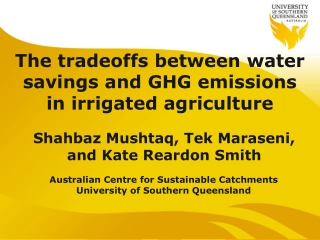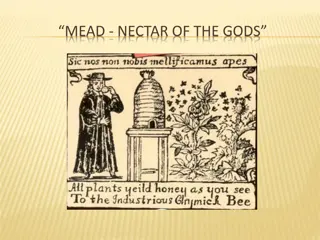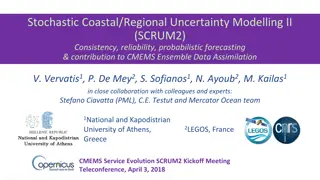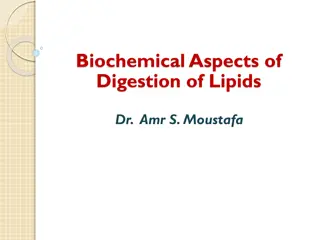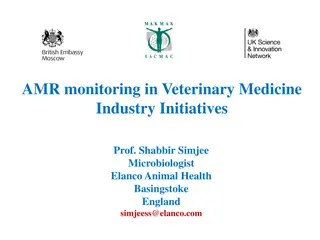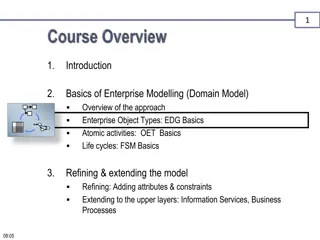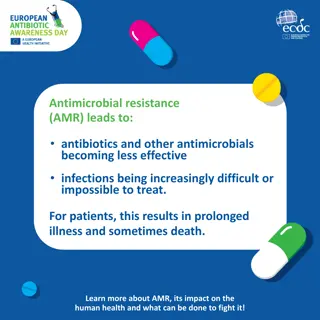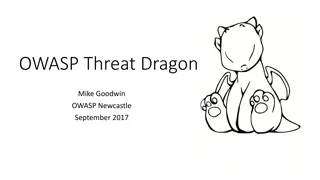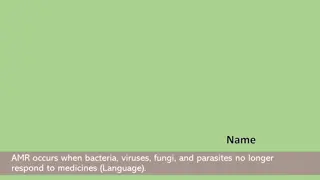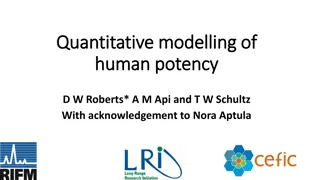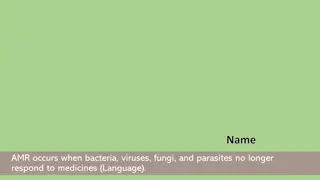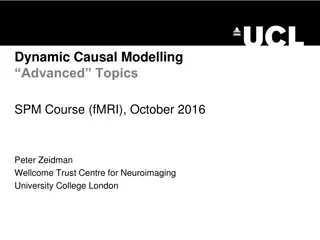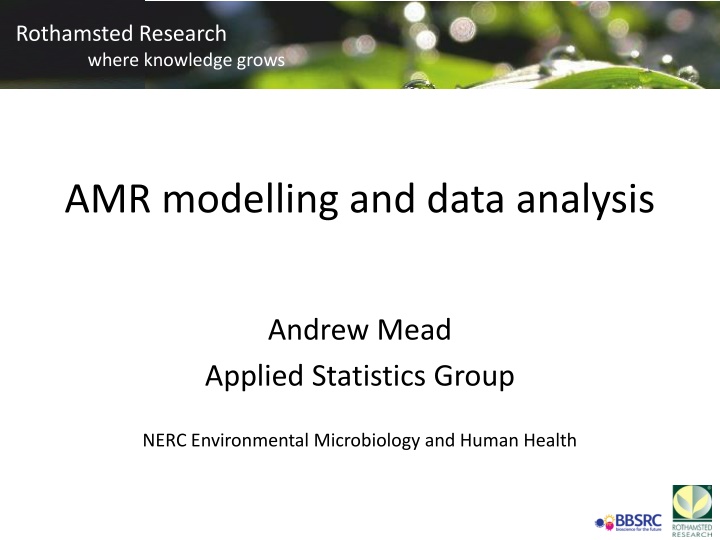
Rothamsted Research Data Analysis and Modelling Report
Exploring data samples from various sites and wastewater treatment plants (WWTPs) to analyze integron prevalence, WWTP characteristics, population data, land cover types, and rainfall information. The study provides valuable insights into environmental microbiology and human health related to antimicrobial resistance (AMR).
Download Presentation

Please find below an Image/Link to download the presentation.
The content on the website is provided AS IS for your information and personal use only. It may not be sold, licensed, or shared on other websites without obtaining consent from the author. If you encounter any issues during the download, it is possible that the publisher has removed the file from their server.
You are allowed to download the files provided on this website for personal or commercial use, subject to the condition that they are used lawfully. All files are the property of their respective owners.
The content on the website is provided AS IS for your information and personal use only. It may not be sold, licensed, or shared on other websites without obtaining consent from the author.
E N D
Presentation Transcript
Rothamsted Research where knowledge grows where knowledge grows Rothamsted Research AMR modelling and data analysis Andrew Mead Applied Statistics Group NERC Environmental Microbiology and Human Health
Data Samples from 13 sites on 4 occasions Log Class 1 integron prevalence measured Locations of 46 WWTPs relative to sampling sites Only those upstream within a 10km radius River distance from WWTP to sampling site Classification of type for each WWTP Population served by each WWTP Percentage land cover data (LCM2007) around each sampling site (2km radius) Rainfall data (period prior to sampling)
WWTP Data Site Number Distance (D) Treatment type (t) Population size (P) Site Number Distance (D) Treatment type (t) Population size (P) 8 8 8 8 8 8 9 9 9 9 9 9 9 9 446 6611 5753 5340 12014 16844 13972 10526 9017 10523 13144 7594 4865 9622 5892 2953 8667 7395 14248 13194 4 1 1 1 2 1 1 1 3 1 1 1 1 1 1 2 1 1 1 4 0 740 1260 500 790 39860 220 1 1 1 1 1 1 1 1 2 2 3 3 3 4 4 5 6 6 6 6 6 6 6 7 7 7 10436 9277 7221 7747 7220 8154 13612 17610 13076 2602 18212 9450 8064 12738 9699 9294 17420 13019 13148 6981 1035 14489 27068 10045 3667 6547 1 1 2 1 1 3 3 3 1 1 1 4 1 5 5 2 6 3 1 1 1 1 1 1 1 3 370 300 500 3340 720 430 250 2250 580 4180 331 320 570 16500 10900 82300 31300 870 4070 2220 6000 920 2530 4010 170 1710 50 620 4080 10 332 10 40 60 5140 65900 900 130 10 10 11 12 12 12 13 90 4140 0 0
LCM2007 land cover types LCM2007 class number Broad Habitat sub-class LCM2007 class number Broad Habitat sub-class Deciduous Recent (<10yrs) Mixed Scrub Conifer Larch Recent (<10yrs) Evergreen Felled Arable bare Arable Unknown Unknown non-cereal Orchard Arable barley Arable wheat Arable stubble Improved grassland Ley Hay Rough / unmanaged grassland Neutral Calcareous Acid Bracken LCM2 007 class LCM2 007 class Bog Blanket bog Bog (Grass dom.) Bog (Heather dom.) Montane habitats Inland rock Despoiled land Water sea Water estuary Water flooded Water lake Water River Supra littoral rocks Sand dune Sand dune with shrubs Shingle Shingle vegetated Littoral rock Littoral rock / algae Littoral mud Littoral mud / algae Littoral sand Saltmarsh Saltmarsh grazing Bare Urban Urban industrial Urban suburban Bog 12 Broadleaved woodland 1 Montane Habitats 13 Inland Rock 14 Coniferous Woodland 2 Salt water 15 Freshwater 16 Supra-littoral Rock 17 Arable and Horticulture 3 Supra-littoral Sediment 18 Improved Grassland 4 Littoral Rock 19 Rough Grassland 5 Littoral sediment 20 Neutral Grassland Calcareous Grassland 6 7 Saltmarsh 21 Acid Grassland 8 Urban 22 Fen, Marsh and Swamp 9 Fen / swamp Heather & dwarf shrub Suburban 23 Burnt heather Gorse Dry heath Heather grass S Heather 10 Heather grassland 11
Land cover percentages LCM2007 classes 6 7.38 0.40 1.93 0.00 3.52 0.00 0.00 0.00 3.80 0.00 0.00 0.00 0.97 0.00 3.86 0.00 3.50 0.06 0.00 0.00 12.14 0.00 5.68 0.00 0.00 0.00 Site TC1 TC2 TC3 TC8 TC9 TC10 TC12 TC14 TC17 TC18 TC19 TC21 TC23 1 2 3 4 5 7 8 11 14 16 22 23 1.55 0.56 3.62 2.92 0.64 2.53 16.49 4.38 3.05 2.65 2.97 9.32 3.04 0.00 0.00 0.00 0.00 0.00 0.00 1.37 0.00 0.20 0.00 0.00 0.24 1.05 44.74 60.69 33.96 51.14 61.73 46.75 35.73 35.19 16.79 42.35 64.47 62.29 18.02 36.46 25.96 46.91 38.91 32.09 27.67 34.57 22.66 41.98 22.20 13.77 12.74 32.05 1.73 3.08 3.50 4.58 0.84 4.02 8.67 1.51 1.83 2.13 3.07 5.12 6.23 0.00 0.00 0.00 0.00 0.00 0.00 0.00 0.00 0.58 0.00 0.00 0.00 0.00 0.00 0.00 0.00 0.00 0.00 0.00 0.00 0.06 0.26 0.00 0.00 0.00 0.20 1.53 0.00 0.00 0.18 0.00 0.90 0.00 0.52 0.00 0.00 2.25 1.11 7.08 0.00 0.00 0.95 0.60 0.90 8.85 0.00 3.92 6.39 2.67 0.00 2.03 16.15 0.40 0.00 0.06 0.18 0.00 0.40 0.00 0.74 2.73 2.69 1.34 0.00 1.67 6.21 7.78 7.48 0.50 0.02 8.89 2.19 27.17 22.64 25.32 0.00 1.57 14.50
Response data (Model 1) Site number Log Mean Integron Prevalence 1 2 3 4 5 6 7 8 9 -0.280349328 -0.750782021 -1.225923478 -0.49321998 0.173932181 -0.777090005 -1.118970796 -0.898046724 -0.61677328 -0.20203761 -1.483509042 -0.509392897 -1.682019008 10 11 12 13
Model 1 WWTP effects only Semi-mechanistic approach Assumption 1: effect (A) of each WWTP (i) depends on size, type and distance from sampling site (j) Size measured by population equivalent (P) 7 types of WWTP defined (Mt, t= 1 7) Only 6 observed in catchment Effect decays with distance (D) following a power law (X) ????(?) ???= ? ??? 1
Model 1 WWTP effects only Assumption 2: total impact (R) of WWTPs at a sampling site (j) is sum of impacts of each individual WWTP nj WTTPs associated with each sampling site Class 1 integron prevalence (CIP) log- transformed to cope with variance heterogeneity Linear regression of CIP against log- transformed total impact of WWTPs ?? ??= ??? ?=1 ??? ??? = ? + ? ??? ??+ 1
Model 1 WWTP effects only Model fitted using general non-linear regression Newton-Raphson algorithm to minimise squared differences between model and observations 10 parameters to estimate (7 WWTP types, distance decay (X), intercept (C = indigenous level), slope (S = rate of increase with increasing WWTP impact) WWTP type parameters are relative So constrain one (for type with maximum response) to estimate others Parameters then give reduction for other WWTP types
Model construction model [function=SS] rcycle [maxcycle=50] param=loading[1...6],Power,Intercept,Slope;\ initial=0.124,0.247,1,0.912,0.272,0,0.388,-1.74448,0.236019;\ upper=6(1),1,0,1; lower=2(0),1,3(0),0,-10,0;\ step=2(0.01),0,4(0.01),0.1,0.01 expr [val=(Loadings[1...6] = loading[1...6]*Treatments[1...6])] \ expr[1] expr [val=(all_loadings = vsum(Loadings))] expr[2] expr [val=(cont=(all_loadings*Population_size)/((Distance+1)**Power))]\ expr[3] expr [val=(resp$[1...13] =\ Intercept+Slope*log(sum(cont*(Site_Number.eq.1...13))+1))] expr[4] expr [val=(SS = sum((Log_Mean_Integron_Prevalence - resp)**2))] expr[5] fitnonlinear [pr=mo,su,es,mon; calc=expr[]; selinear=yes]
Fitted parameters Parameter Value WTTP type (Mt) parameters 1 Secondary biological (SB) 0.1239 2 Tertiary activated sludge 2 (TA2) 0.2471 3 Tertiary biological 1 (TB1) (fixed) 1.0000 4 Secondary activated sludge (SA) 0.9115 5 Tertiary biological 2 (TB2) 0.2722 6 Tertiary activated sludge 1 (TA1) 0.0100 Regression parameters S (rate of increase of integron prevalence) 0.5426 X (decay of impact with distance) 0.3875 C (indigenous level of antibiotic resistance in soils) -1.7440
Model checking 0.5 Fitted model provides predictions of log mean integron prevalence for each sample location Simple linear regression of observed values (4 different seasons) against predictions Adjusted R2 = 0.495 Actual log integron prevalence 0.0 -0.5 -1.0 -1.5 -2.0 0.0 0.5 1.0 1.5 2.0 2.5 Predicted log integron prevalence
Response and explanatory data (Model 2) Log Integron prevalence Rainfall day beforeLog Rainfall 0.51 0.51 0.51 0.51 0.51 0.51 0.51 0.51 0.51 0.51 0.51 0.51 0 0 0 0 0 0 0 0 0 0 0 0 0 2.8 2.8 2.8 2.8 Site TC1 TC2 TC8 TC9 TC10 1.437844986 TC12 1.09615238 -1.190013086 TC14 2.302748075 -0.751812868 TC17 2.771169249 -0.470545575 TC18 2.017142179 -1.549012174 TC19 1.861053654 TC21 2.0949495 TC23 2.880226649 -0.356534217 TC1 1.969833968 -0.562604167 TC2 2.524137944 -0.779308327 TC3 0.63555794 -1.412938056 TC8 TC9 1.98799373 -0.693043606 TC10 1.437844986 -0.630632858 TC12 1.09615238 -0.955437261 TC14 2.302748075 -1.038630757 TC17 2.771169249 0.067769947 TC18 2.017142179 -0.892125487 TC19 1.861053654 -1.011995807 TC21 2.0949495 -1.211796024 TC23 2.880226649 -0.855788485 TC1 1.969833968 0.101738363 TC2 2.524137944 -1.189564972 TC3 0.63555794 TC8 Log R 1.969833968 -0.572518394 2.524137944 0 -1.470952226 1.98799373 -0.527623748 Season 1 1 1 1 1 1 1 1 1 1 1 1 2 2 2 2 2 2 2 2 2 2 2 2 2 3 3 3 3 0.178977 0.178977 0.178977 0.178977 0.178977 0.178977 0.178977 0.178977 0.178977 0.178977 0.178977 0.178977 -0.95493767 Log Integron prevalence Rainfall day beforeLog Rainfall 2.8 2.8 2.8 2.8 2.8 2.8 2.8 2.8 3.81 3.81 3.81 3.81 3.81 3.81 3.81 3.81 3.81 3.81 3.81 3.81 Site TC9 TC10 1.437844986 -0.545645316 TC12 1.09615238 -1.684321248 TC14 2.302748075 -1.664827194 TC17 2.771169249 0.205933323 TC18 2.017142179 -0.698709612 TC21 2.0949495 -0.416222489 TC23 2.880226649 0.124667471 TC1 1.969833968 -0.534328969 TC2 2.524137944 -0.785014844 TC3 0.63555794 -1.390948706 TC8 TC9 1.98799373 -0.539850237 TC10 1.437844986 -1.445037953 TC12 1.09615238 -1.379829514 TC14 2.302748075 -0.002351016 TC17 2.771169249 0.455796504 TC18 2.017142179 -0.506216161 TC21 2.0949495 -0.585740068 TC23 2.880226649 -0.221763146 Log R 1.98799373 -0.346925794 Season -0.80859654 3 3 3 3 3 3 3 3 4 4 4 4 4 4 4 4 4 4 4 4 0.579784 0.579784 0.579784 0.579784 0.579784 0.579784 0.579784 0.579784 0.682145 0.682145 0.682145 0.682145 0.682145 0.682145 0.682145 0.682145 0.682145 0.682145 0.682145 0.682145 -1.26122087 -0.58136756 0 0 0 0 0 0 0 0 0 0 0 0 0 0 -1.838857454 0 -1.656084655 0.579784 0.579784 0.579784 0.579784 -1.71560132 0 -1.892593092
Model 2 WWTP plus land-cover and rainfall Multiple linear regression of log(CIP) WWTP impacts using calculated log(Rj) values for each sample site using fitted Model 1 Land-cover percentages for range of major classes Log-transformed values (Normalised values) Allow different effects of land-cover classes indifferent seasons Regression with groups Rainfall on day prior to sampling Including combinations of rainfall values with land-cover percentages All-subsets and stepwise regression approaches used to find best model 8 land-cover variables included, plus interactions with rainfall and season
Fitted parameter values Parameter Constant R(Total impact of WWTPs) Coniferous woodland Rough grassland Neutral grassland Acid grassland Heather grassland Inland rock Urban Suburban Coniferous woodland.rainfall Neutral grassland.rainfall Acid grassland.season 2 Acid grassland.season 3 Acid grassland.season 4 Heather grassland.season 2 Heather grassland.season 3 Heather grassland.season 4 Inland rock.season 2 Inland rock.season 3 Inland rock.season 4 Urban.season 2 Urban.season 3 Urban.season 4 Suburban.season 2 Suburban.season 3 Suburban.season 4 Coefficient Standard error t-Value Significance level -0.778 0.3207 1.748 -1.272 -0.478 8.29 -7.77 1.476 -1.771 0.160 -1.41 0.994 5.24 7.91 -8.64 -11.38 -18.70 13.37 -0.321 1.607 -1.538 1.174 3.370 2.323 0.046 -0.822 -0.218 0.305 0.0723 0.711 0.416 0.190 3.36 5.76 0.461 0.503 0.159 1.15 0.386 3.99 4.33 4.53 6.55 7.60 7.84 0.514 0.599 0.614 0.684 0.810 0.846 0.178 0.217 0.235 -2.55 4.43 2.46 -3.05 -2.51 2.47 -1.35 3.21 -3.52 1.01 -1.22 2.58 1.31 1.83 -1.91 -1.74 -2.46 1.71 -0.62 2.68 -2.50 1.72 4.16 2.75 0.26 -3.79 -0.93 0.018 <0.001 0.022 0.006 0.020 0.022 0.191 0.004 0.002 0.326 0.234 0.017 0.203 0.081 0.069 0.097 0.022 0.102 0.539 0.014 0.020 0.100 <0.001 0.012 0.798 0.001 0.365
Model checking Predict log integron prevalence based on the fitted model Simple linear regression of observed on predicted demonstrates quality of fit Adjusted R2 = 0.829 actual log integron prevalence 0.5 0.0 -0.5 -1.0 -1.5 -2.0 -2.0 -1.5 -1.0 -0.5 0.0 0.5 Predicted log integron prevalence
Model 3 water quality parameters Separate multiple linear regression analysis of log(CIP) Range of water quality parameters included All-subsets and stepwise regression approaches used to find best model Strong correlations between water quality parameters (collinearity) 11 water quality parameters included Model fit not as good as for Model 2 (71.4% variance accounted for compared with 82.9%) Potential to extend Model 2 by including water quality parameters Providing additional explanatory power Or use water quality parameters to parameterise effects of land cover?
Metagenomic data new project More complex data sets with multiple response variables Consider individually, or summarise patterns using multivariate approaches Principal Component Analysis, Correspondence Analysis, Hierarchical Cluster Analysis Identify groups of samples with similar profiles Identify genes contributing to differences Canonical Variate Analysis, Canonical Correspondence Analysis allow a more direct association of relative gene abundance patterns to environmental (water quality) parameters Identify groups of genes that provide basis for combining information for model development Also consider measures of diversity, and functional groups
New modelling approaches Use Low Flows 2000 Water Quality Extension (LF2000- WQX) to better quantify effect of river distance from WWTPs to sampling sites Allows assessment of between-season variation Allows incorporation of variability/uncertainty due to structure of river system General non-linear multiple regression Impacts of WWTPs (using LF2000-WQX) Extend using subsets of landscape/environmental variables Links between land-cover and water quality variables?? Models for individual genes Models for combined responses for groups of similar genes From multivariate analyses, functional groups, Models for other summaries of genes, e.g. diversity measures Identify where there are common parameters across models extend/combine using multivariate regression?
Validation and Prediction Validation of fitted models Using a cross-validation approach Re-fit models to data for a subset of sampling points and compare predictions and observations at omitted sampling points Repeat for multiple omitted subsets Prediction and mitigation Predict risk of ARGs across the whole river system Explore impacts of different mitigation strategies

